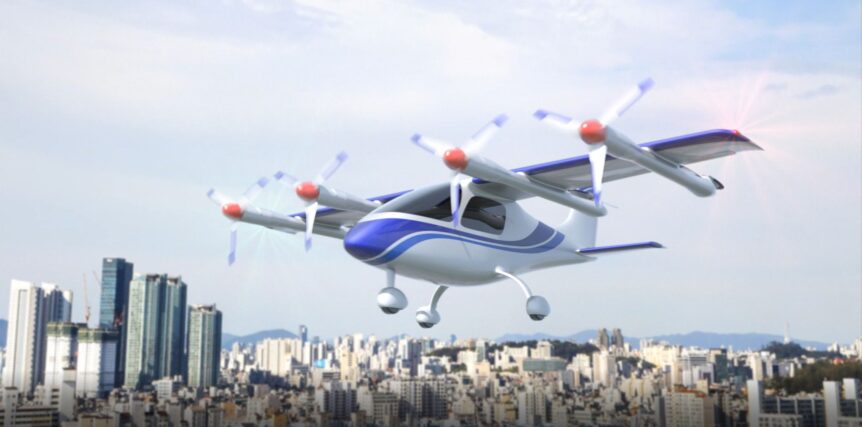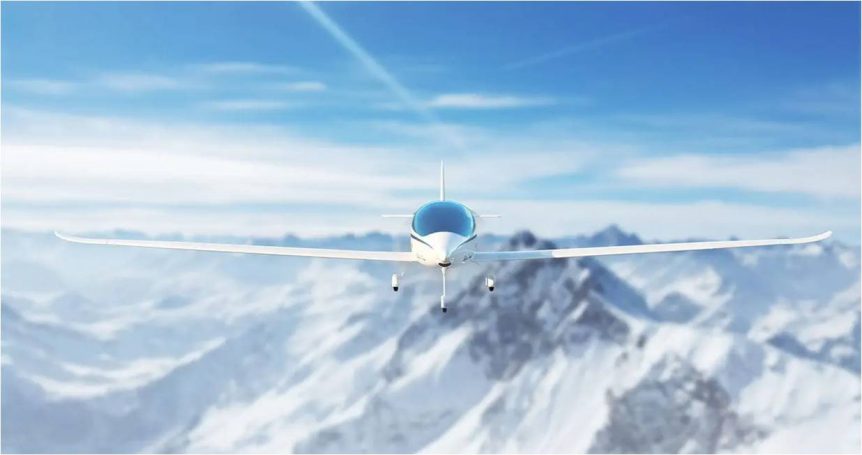Single-seat ultralight aircraft are a popular part of personal aviation and a small part of the growing electric Vertical Take Off and Landing (eVTOL) market. We look at two contenders here, and compare them to a newly-certificated single-seat fixed-wing solar-assisted airplane. KARI’s QTP-UAV KARI – the Korean Aerospace Research Institute – has developed the QTP-UAV, or Quad Tilt-Prop Unmanned Aerial Vehicle. It’s designated as yet another acronym – OPPAV, Optionally Piloted Personal Air Vehicle Technology Demonstrator. Citing the “Emerging market competition for urban air mobility,” KARI sees their craft as a means to reduce the “enormous social costs resulting from traffic increase on the ground.” A huge number of Korean organizations joined the effort develop the OPPAV demonstrator. “Korean companies (KAI, Hyundai Motors, Hanwha System, VesselAerospace, KAT, Doota, EDT, and RealtimeWave), research institutes (KIAST and KOTI), and Konkuk University formed a consortium for the program sponsored jointly by the Ministry of Land, Infrastructure, and Transport (MOLIT) and the Ministry of …
Elektra Trainer – Flight Training for the New Age
A Decade of Development A modified version of Elektra One, flying since 2011 and certified in the German ultralight class, Calin Gologan’s Elektra Trainer could provide affordable flight training with lower operating costs. Calin displayed Elektra One at the 2012 AirVenture show in Oshkosh, Wisconsin, flying daily on the power of its solar-charged batteries. The company details its background. ” Elektra Solar GmbH is a spin-off from the German Aerospace Center (DLR), Institute for Robotics and Mechatronics. The roots of the company go back to 2011. This year PC-Aero GmbH was founded in 2011 by Calin Gologan. Elektra One electric aircraft was the first product flying in March 2011. “In the same year, we [received] the Lindbergh Prize for Electric Aircraft Vision. Elektra UAS GmbH was founded in 2012 for unmanned systems and application. Both companies merged in 2016 under the new name Elektra Solar GmbH. “In 2015 we flew with the Elektra One Solar for the first time over …
The Green Speed Cup – Fourth Edition
Robert Adam helps run the Green Speed Cup, a time, speed and economy run for aircraft in Germany. The rules for this year’s contest elucidate the intent and ambitions for the event: “The GREEN SPEED CUP is an aviation competition focusing on efficient flight. The emphasis lies on fast and energy saving transportation. The competition is meant to develop new methods to reduce energy consumption of motor driven aircraft using external energy sources like lateral winds and updrafts. In making the ability of certain aircraft and techniques transparent, the competition shall set new standards in general aviation.” The Cup provides a sounding board for discussion of energy efficient flight and the changing experience of flying while exploring new techniques and technologies. Hosted by STEMME Aviators e.V., the contest is open to “all aircraft capable of taking off under their own power,” with the following restrictions: In the Electric Class, airplanes may have one to four seats, weigh up to 2,700 …
Friedrichshafen Becomes Elektra
Dr. Birgit Weißenbach, who heads up marketing for PC-Aero, the German firm that produces light electric and solar-powered aircraft, sends two pictures from the company’s display at Aero Expo, now taking place in Friedrichshafen, Germany. The display is overflown by a 1/5-scale model of Elektra Two, their anticipated two-seat electric airplane with solar cells, a design intended for travel, training and flying clubs. Another model, the Elektra Observer LT, represents their unmanned “Very Light Electric Aircraft” with solar cells to allow long-duration civil surveillance. On the floor, Elektra One has its full complement of Solar World solar cells, which supplement its battery power. Elektra One Solar has longer wings and a larger solar cell area, both extending its range. Both use the Flytec HP-13.5 motor and controller, associated battery pack, and claim up to three hours endurance and 400 kilometers (250 miles) range. Dipl. Ing. Calin Gologan, founder and President of PC-Aero, will hold a press conference April 18 and …
Aero-PC and SolarWorld, Ford and SunPower Light Up Transportation
With electric aircraft showing the possibilities of a greener future, it’s rewarding to see similar efforts to produce cleaner, off-the-grid ground transportation. Calin Gologan had a gala week at AirVenture, speaking at the Electric Aircraft World Symposium to detail his Elektra One Green Flight Challenge entrant and to introduce his Elektra Two and Four two-seat and four-seat, respectively, electric aircraft. He was awarded the Lindbergh Electric Aircraft Prize (LEAP) for the quietest electric aircraft by Erik Lindbergh, Charles’ grandson. Saturday, July 30 saw Norbert Lorenzen, test pilot for PC-Aero and owner of a flight school near Landshut, Germany, take Elektra One for a spin around the Oshkosh airspace. Note Molt Taylor’s Aerocar zipping by between the 15 and 18 second marks on the video. On the ground, the airplane was dollied out for takeoff,“overseen” by the capable Howard Handelman, who also noted something that Gologan had confirmed to Brien Seeley, President of the CAFE Foundation. The SolarWorld solar cells on …
PC-Aero Wins Lindbergh Electric Aircraft Vision Award
A Green Flight Challenge entrant, PC-Aero’s Elektra One, has won the Lindbergh Electric Aircraft Vision Award at AirVenture 2011 in Oshkosh, Wisconsin, becoming the latest winner of this important award for innovation in the pursuit of “green” aviation. Past winners of the Lindbergh Prize for Electric Aircraft include: Pipistrel: 2011 Aero-Friedrichshafen Best Electric Aircraft LZ Design: 2011 Aero-Friedrichshafen Best Electric Propulsion System Solar Impulse: 2011 Aero-Friedrichshafen Outstanding Achievement Award Yuneec International: 2010 AirVenture Best Electric Aircraft Sonex: 2010 AirVenture Best Electric Aircraft Subsystem Lange Aviation: 2010 AirVenture Individual Achievement Award According to Erik Lindbergh, grandson of Charles Lindbergh and founder of LEAP, the organization’s, “Programs recognize, inspire and incentivize the innovation that drives our culture, economy and future. The LEAP Electric Flight Program is accelerating the development of the electric aircraft industry through a range of activities, from prizes to advocacy.” This year’s award, “Focuses on innovation with a “vision” for integrated electric power for an aircraft and its supporting …
Elektra One Flies Into Oshkosh with Solar Cells
As described before in this blog, PC-Aero’s Elektra One is a single-seat electric airplane with an Eck/Geiger 13.5 kilowatt motor in the nose, and now at least partially solar powered. http://www.youtube.com/watch?v=r03nim-6qBw&feature=related Designer Calin Gologan gives a walkthrough of the design features which make Elektra One such an efficient airplane, and one likely to give other competitors in the Green Flight Challenge a good run. While he describes the thin carbon-fiber shells which comprise the airplane’s primary structure, notice the light shining through. That thinness helps explain Elektra One’s 100 kilogram (220 pounds) empty weight, only about 100 pounds of which is structure. The motor is 4.7 kilogram (10.34 pounds) and the controller is a 270 gram (9-1/2 ounce) model airplane marvel. Batteries can add up to 100 kilograms and the pilot another 100 kilograms, making the strength-to-weight ratio of the craft rather impressive, and its payload carrying abilities among the greatest for flying machines. Gologan claims a maximum range of 500 …
A Useful Spreadsheet and GFC Handicapping Tool
For analyzing the greatest economy from an aircraft’s design, Howard Handelman, a highly-engaged reader of this blog, provides a link to his web site, which includes a downloadable spreadsheet he has devised that will give the inquiring reader hours of enjoyment. Handelman, self-described as, “just a retired IT guy,” with “weak math skills,” but a “compulsively curious” nature, has devised a tool for analyzing any airplane’s performance based on a few known variables, and which he has applied to many of the Green Flight Challenge’s aircraft. The basis for his analyses is his “triangle tool,” a wedge that can be used to help design propellers, “test [the] truth” of claimed aircraft performance, and estimate brake horsepower in real life circumstances (at least within the parameters of the triangle tool). Handelman notes that some aircraft, including those with laminar flow, will “not fit the model very well because they don’t fit the V-squared curve. Synergy won’t look anything like the model.” His findings …
The Electric Firefly Sets Two World Records
Jean-Luc Soullier has converted Michel Colomban’s two-cylinder internal combustion MC-30 Luciole (Firefly) into an electric aircraft – not without some teething problems, but with plenty of promise. His group, LSA, Luxembourg Spécial Aerotechnics, consists of Jean-Luc, Martin Marschner von Helmreich, and Fabrice Tummers – and has terrific ambitions. Fabrice, in response to questions about the record attempts, sent the following: “Our target in 2011 is to realize the totality of the world records of the F.A.I. in the category RAL 1E, and cross the Mediterranean Sea. The first attempt [a speed record] was not ratified by the F.A.I. but the medium speed recorded was 160 kilometers per hour (99.4 mph) over 15 kilometers. (9.3 miles)” With the 118 pounds of batteries now on board, the airplane has more than one hour endurance, but a proposed switch to hydrogen fuel cells will allow six-hour flights and make Mediterranean crossings a breeze. If the team can keep the motor and controller cool. Reports …
Elektra One Has First Flight
The brief press release and single photograph from PC-Aero says it all: “ELEKTRA ONE from PC-Aero performed successfully its First Flight for about 30 minutes. Using only 3 kWh of energy. “The internal First Flight was performed by the well known testpilot Jon Karkow. He did the first check for the flight performance and characteristics of the electric aircraft and briefed the german testpilot Norbert Lorenzen for the next official First Flight.” Although static tests were completed late last year, speculation that Germany’s tough certification laws held up test flights ran through some of the aviation press. The angle of the photograph makes it difficult to tell whether the center-line landing gear was retracted or not, but the low energy use indicates the gear might have been tucked up. Energy use certainly reflects designer Calin Gologan’s assertion that “Elektra One needs only about 6.5 kW/h at 100 MPH. This will be equivalent with about 500 passenger MPG.” Elektra One is …
- Page 1 of 2
- 1
- 2


